Greater Horseshoe
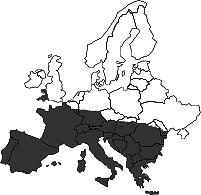 The
Horseshoe bats can be distinguished from other British bats by the presence
of a complex horseshoe-shaped noseleaf, which is related to their particular
type of echolocation system. Instead of using their larynx to produce sonar
they use their nose and emit a 90 degree cone of ultrasound through their
noseleaves.
The
Horseshoe bats can be distinguished from other British bats by the presence
of a complex horseshoe-shaped noseleaf, which is related to their particular
type of echolocation system. Instead of using their larynx to produce sonar
they use their nose and emit a 90 degree cone of ultrasound through their
noseleaves.
When roosting they hang free with the wings more or less enfolding their
body. An advantage when it comes to recording them as they do not hide
in crevices making them easier to spot. The Greater Horseshoe bat is one
of our largest species - the size of a small pear.
The Greater Horseshoe bat has shown a marked decline, particularly in
western Europe. It is rare in Britain and now confined to south-west England
and South Wales. It is estimated that the number of Greater Horseshoe
bats has declined by 98% in the last 100 years. The British population
is thought to number only between 4,000 and 6,000 individuals.
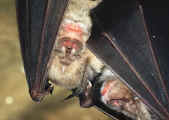 The
decline of the Greater Horseshoe bat may due to the factors such as disturbance
of roosts and intensive agricultural practices including loss of permanent
pasture. They are particularly sensitive to disturbance at their nursery
and winter roosts. These sites need to be specifically protected and entrance
holes left unobstructed.
The
decline of the Greater Horseshoe bat may due to the factors such as disturbance
of roosts and intensive agricultural practices including loss of permanent
pasture. They are particularly sensitive to disturbance at their nursery
and winter roosts. These sites need to be specifically protected and entrance
holes left unobstructed.
The conservation of their feeding habitats and food sources is also important.
The use of pesticides has led to a decrease in availability of larger
beetles, particularly cockchafers, and moths over large areas of the countryside.
Download a pdf
copy of "Managing Landscapes for the Greater Horseshoe Bat"
by English Nature (228Kb).
Research by Stephen Rossiter of the University of Bristol, Roger Ransome and
colleagues (Proceedings of the Royal Society of London B, vol 268 pp1053-60)
has suggested that the overwinter survival rates of males is related to
their degree of inbreeding - less inbred individuals were more likely
to survive their 1st and 2nd winters. The researchers conclude that inbred
bats may have weaker immune systems and are, therefore, less able to withstand
disease. These results mean that it is very important to protect the mating
sites where pairings occur between bats from different colonies.
In 2003 English Nature commissioned a study to radio-track Greater Horseshoe
bats in Dartmoor. They found that they did not forage much within woodland
but preferred a mixture of habitats. These included tree-lined watercourses,
tall bushy hedges, and tree-lines around grassland or scrub. The adult
bats were happy to commute 6km to these feeding areas but the juveniles
stayed within 4km of the roost. Also the research showed that an enclosed
corridor of vegetation outside the roost is important as it allow them
to emerge safely before it gets totally dark.
flight & ultrasound

Greater Horseshoe bats emerge from their roosts within half an hour of
sunset. Between May and August they usually return to their roost after
about an hour and remain there until their second feed around dawn. However,
from late August they may remain away all night. They require a mosaic
of woodland and pasture to ensure an adequate food supply whatever the
weather conditions. For example, during a chilly Spring evening woodland
is better while in the warmth of summer nights pasture provides a bountiful
supply of moths and beetles.
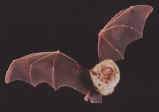 Insects
are taken in flight or occasionally from the ground. Greater Horseshoe
bats often behave like flycatchers, 'watching' from a regular perch and
flying out to take passing insects. Large prey is taken to a regular feeding
perch; insect remains beneath such perches in trees, porches or cave entrances
are most evident spring or autumn. Greater Horseshoe bats feed mainly
by low-flying hunting.
Insects
are taken in flight or occasionally from the ground. Greater Horseshoe
bats often behave like flycatchers, 'watching' from a regular perch and
flying out to take passing insects. Large prey is taken to a regular feeding
perch; insect remains beneath such perches in trees, porches or cave entrances
are most evident spring or autumn. Greater Horseshoe bats feed mainly
by low-flying hunting.
Greater Horseshoe bats have an almost constant frequency call of about
82 kHz. On a heterodyne bat detector a
series of continuous warbles can be heard. It is just as well that we
cannot hear their calls as at a distance of 10cm they are comparable to
the energy of a jet aeroplane! (27 Newtons per square metre).
Horseshoe bats rely on the apparent change in frequency caused by the
relative movement of a sound source and receiver. This change called Doppler
shift, is the same phenomenon that appears to make the pitch of the
siren on an approaching police car grow higher as it approaches and then
deepen as it passes by. The Horseshoe bats compare the pitch that they
emit from their noses to that which returns to their ears. In this way
they can distinguish a stationary tree from a flying insect. So they are
very insensitive to the emitted frequency and exceptionally sensitive
to frequencies just above and below it.
 Greater Horseshoe recorded on a Heterodyne bat detector
Greater Horseshoe recorded on a Heterodyne bat detector
breeding
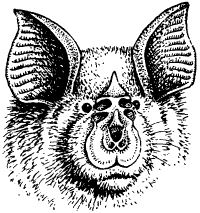 In
the autumn males form separate colonies where oestrous females visit them
to mate. Mating can also take place in late winter or even in spring.
In
the autumn males form separate colonies where oestrous females visit them
to mate. Mating can also take place in late winter or even in spring.
Maternity colonies begin to gather in May and reach peak numbers in
mid-June to July when most breeding females return. Males up to 14 years
old return with breeding females in June, but most leave when the young
are born in mid-July.
Birth often occurs at dusk. The female hangs from her feet and the single
baby emerges into the overlapped wings. Shortly afterwards the young is
left in the roost while the mother flies off to feed. The young can open
their eyes at nine days of age. At first the young feed on their mother's
milk, but after about 5 weeks can fly and start to catch insects. They
are fully weaned at 7 weeks when the adults usually leave the colony but
juveniles and some immature bats may stay until October or even later.
Females Greater Horseshoe bats are not usually sexually mature until
their third year and one female did not breed until her tenth year. They
may not breed every year. Males are usually sexually mature by their second
or third year.
summer roosts
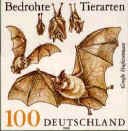 Greater
Horseshoe bats were originally cave dwellers but few now use caves in
summer as they are now too few bats of this species to generate the amount
of body heat to successfully raise their young. So, most breeding females
use buildings which are warmed by the sun. They choose sites with large
entrance holes with access to open roof spaces as, like the Lesser Horseshoe,
they prefer to fly directly into a roost site. Such sites are normally
in larger, older houses, churches and barns. A range of other sites are
used in Spring, and males hold territory at mating roosts in autumn.
Greater
Horseshoe bats were originally cave dwellers but few now use caves in
summer as they are now too few bats of this species to generate the amount
of body heat to successfully raise their young. So, most breeding females
use buildings which are warmed by the sun. They choose sites with large
entrance holes with access to open roof spaces as, like the Lesser Horseshoe,
they prefer to fly directly into a roost site. Such sites are normally
in larger, older houses, churches and barns. A range of other sites are
used in Spring, and males hold territory at mating roosts in autumn.
These bats form clusters inside maternity roosts to keep warm but will
spread out if the roost gets too hot. Maternity colonies can be noisy
with continuous chattering, chirping and scolding calls. Males also use
caves and tunnels in the summer and even the breeding females appear to
need a nearby cave or tunnel to retreat to when bad weather affects their
food supply.
Winter Roosts
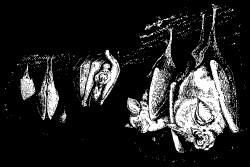 The
Greater Horseshoe bat uses caves, disused mines , cellars and tunnels
as hibernation sites. These sites can be up to 50 km from the breeding
roost. They may hibernate from late September to mid-May, depending on
the weather and food availability. They awake from hibernation at frequent
intervals and, in their search for suitable temperatures, movements of
30 km between sites are often recorded. They will feed in winter during
mild weather.
The
Greater Horseshoe bat uses caves, disused mines , cellars and tunnels
as hibernation sites. These sites can be up to 50 km from the breeding
roost. They may hibernate from late September to mid-May, depending on
the weather and food availability. They awake from hibernation at frequent
intervals and, in their search for suitable temperatures, movements of
30 km between sites are often recorded. They will feed in winter during
mild weather.
 Hibernation
sites are much warmer than those of many other bats with temperatures
varying from about 11ºC in October to about 7ºC in February, although
this varies with age, sex and body condition. They will sometimes form
clusters in winter sites although adult females are more solitary.
Hibernation
sites are much warmer than those of many other bats with temperatures
varying from about 11ºC in October to about 7ºC in February, although
this varies with age, sex and body condition. They will sometimes form
clusters in winter sites although adult females are more solitary.
Generally, female Greater Horseshoe bats are found deep within the hibernaculum
and move little throughout the winter. Females are usually much fatter
and can afford to find a relatively warm place to hibernate. The males
however often keep nearer to the entrance and frequently move site. Immature
Greater Horseshoe bats are highly gregarious at all times and can form
groups with adult males of up to 300 in winter.
| Description |
|
| Head and Body Length |
57 - 71 mm |
| Forearm Length |
54 - 61 mm |
| Wingspan |
350 - 400 mm |
| Weight |
17 - 34 g |
| Colour |
Adults buff-brown; juveniles greyish. |
|
|
| |
|
| Life Cycle |
|
| Mating Period |
Late September - October |
| Maternity Colonies |
Late spring.
Young: usually 1 born mid-July, weaned within 7 weeks. |
| Colony Size |
50 - 200 (rarely 600) |
| Longevity |
Up to 30 years. |
| UK Status |
Endangered. |
|
|
| |
|
| Habitat and Food |
|
| Summer Roosts |
Mainly buildings. |
| Winter Roosts |
Caves, disused mines, cellars, tunnels. |
| Feeding Habitat |
Deciduous woodland, scrub, permanent pasture, water,
along hedgerows. |
| Food |
Chafers and dung beetles, noctuid moths, crane-flies,
caddisflies.

|
further reading
Dietz C, Dietz I and Siemers BM: Wing measurement variations in the five
European horseshoe bat species (Chiroptera: Rhinolophidae). Journal of
Mammalogy, (2006).
Dietz C, Dietz I and Siemers BM: Growth of horseshoe bats (Chiroptera:
Rhinolophidae) in temperate continental conditions and the influence of
climate. Mammalian Biology, (2006).
Dietz C, Dietz I, Ivanova T and Siemers BM: Movements of horseshoe bats
(Rhinolophus, Chiroptera: Rhinolophidae) in Northern Bulgaria. Myotis,
(2006).